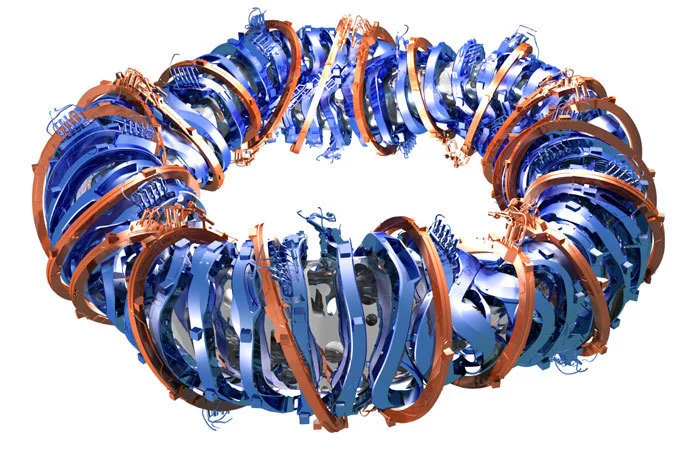The Wendelstein 7-X stellarator is an experimental nuclear fusion reactor designed to bring us closer to the prospect of clean, limitless energy, and since producing its first plasma in 2015 we've seen it take steady and significant steps toward that aim. Physicists have just confirmed another "major advance" that could see the reactor host plasma twice as hot as the Sun's core as a result of efforts to address inherent energy losses in the design.
Stellarators stand apart from the more common, symmetrical doughnut-shaped tokamak fusion reactors as hugely complex structures full of twists and turns. As it is with all nuclear fusion reactors, the goal is to recreate the processes at play within the Sun, by subjecting streams of plasma to extreme temperature and pressure, forcing atoms to collide and fuse together to produce monumental amounts of energy.

The Wendelstein 7-X reactor is so complex it required supercomputers to design. It uses a series of 50 superconductive magnetic coils to hold in place plasma as it loops around a twisting and turning circular chamber. In 2018, physicists working on the project set new records for energy density and plasma confinement for a fusion reactor of this type.
These experiments also saw the plasma heated to temperatures of 20 million °C (36 million °F), comfortably exceeding the Sun's temperature of 15 million °C ( 27 million °F). But it turns out the Wendelstein 7-X might be destined for far higher temperatures than that.

In designing the Wendelstein 7-X, engineers set out to address one limitation that plagues classic stellarator designs far more than tokamaks, a type of heat loss known as "neoclassical transport." This occurs as collisions between the heated particles knock some out of their orbit and cause them to drift outward from the magnetic field. The magnetic field cage of the Wendelstein 7-X was very carefully optimized to prevent these types of losses.
To determine whether that careful planning has paid off, scientists from the Max Planck Institute for Plasma Physics and Princeton Plasma Physics Laboratory (PPPL) have carried out detailed new analysis of the stellarator's round of record-breaking experiments. This analysis focused on diagnostic data collected by X-ray imaging crystal spectrometer, and showed a sharp reduction in neoclassical transport and revealed that, indeed, the high temperatures could not have been achieved otherwise.
“This showed that the optimized shape of W7-X reduced the neoclassical transport and was necessary for the performance seen in W7-X experiments,” says PPPL physicist Novimir Pablant. “It was a way of showing how important the optimization was.”
This performance was achieved with what's described as currently available "modest heating power," and, according to the scientists, the analysis shows that the Wendelstein 7-X is capable of confining heat that reaches temperatures twice as high as those found in the Sun's core in the future. But as the team pursues nuclear fusion there are many balls to juggle other than hitting high temperatures, including addressing other forms of heat loss. Further experiments are slated for 2022, and will involve a new water-cooling system design to allow for lengthier experiments.
“It’s really exciting news for fusion that this design has been successful,” says Pablant. “It clearly shows that this kind of optimization can be done.”
A paper describing the research was published in the journal Nature.
Source: PPPL




